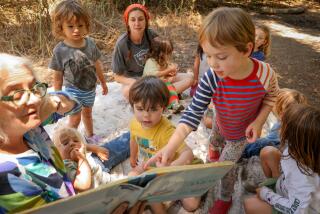Real-Life Stories : Special School Gives Homeless Children a Chance to Live and Learn
On a sunlit Tuesday morning, Lori Wheeler arrives to teach in a one-room school at the Long Beach Family Shelter.
As she shuffles papers on her desk, her students begin to trickle in--some hand in hand with brothers or sisters.
Like most students in Long Beach public schools, the children spend their days reading stories, working on math problems and learning to spell. Unlike most, the children--in kindergarten through eighth grade--will be attending for just a few days or weeks.
Wheeler teaches children whose families have been uprooted by domestic violence, unemployment, disputes with landlords or other problems. The children had to leave school when families moved to shelters or low-cost hotels nearby while piecing their lives together and searching for jobs or housing.
“Many families going through this difficult period don’t want their kids sent off to different schools throughout the district,” said Wheeler, who also serves on a state advisory committee for homeless children’s programs.
The Mary McLeod Bethune School, which opened four years ago, is one of two in the state that has been established to teach children without homes.
*
“We try to get children prepared to go back to a regular classroom with as little loss of education as possible,” said Wheeler. “We want to give them a sense of continuity during an unstable and potentially disruptive period in their lives.”
On a recent morning, students tinkered on computers, worked out math problems and hunkered over storybooks.
Students in kindergarten through second grade worked on pronouncing letters of the alphabet with a teacher’s aide. Older classmates took turns reading “A Hundred Dresses,” a tale about a young girl who was so ashamed of being poor she pretended to own a closet full of fancy clothes even though classmates saw her wear the same tattered outfit day after day.
Michelle, a talkative fifth-grader whose mother stays at a battered women’s shelter, said she understood why the girl lied about having nice clothes. “She didn’t want her classmates to make fun of her,” she said. “Sometimes, you make believe because the truth is embarrassing.”
Wheeler nodded in agreement. A few years ago, she recalled, a homeless boy in a middle school “walked around and around the neighborhood with his friends until they all had gone home.” He did not want his classmates to know he was homeless, she said.
*
Many homeless children fall behind academically because they attend school sporadically, said Judy Seal, who serves on the school district’s advisory board for homeless children’s education. “The school provides these students with tutoring and other remedial services,” she said.
The students also can take part in after-school arts and science classes. In the classroom decorated with artwork and flags of different countries, students dissected frogs. They also go on nature walks at local parks to learn about wildlife. On Thursdays, the students go to the downtown Long Beach YMCA for swimming, basketball and other recreational activities.
Before the school was established, many parents at the shelter kept their children out of regular classes, said shelter director Victor Cardena. Some parents had problems transporting their children to school. Others simply were ashamed. “There is a certain sense of embarrassment and shame parents feel,” said Cardena. “Some are afraid their children will be taken away from them.”
Long Beach Unified School District Supt. Carl A. Cohn has been one of the school’s strongest supporters. He helped start the school four years ago when he was an area superintendent. When the school lost a federal grant that had provided part of its funding, he made sure the district made up the difference.
Cohn identifies with the children’s plight. He was born in a clinic for poor families--ironically in the same building that now houses the shelter’s school.
“Of all the things that we do, this program probably comes closest to realizing the dream that every educator has of serving youngsters who are most in need,” he said.
During his family’s six-week stay in the shelter, Dennis Washington sent his seven children, ages 5 to 14, to Wheeler’s class. Even after moving out of the shelter, Washington drove the children to the school each day until he could enroll them in regular classes.
“The kids really enjoyed the extra attention the teacher gave them,” said Washington, a lean, soft-spoken man whose family was flooded out of its Compton apartment during the winter storms. The family stayed at several motels, then came to the shelter when their money ran out.
Wheeler’s class size ranges from three to 25 students, and she rarely plans lessons for more than a day because of the fluctuating enrollment. But she doesn’t mind that her students stay for just a little while.
“It means they’re getting their lives back together and moving on,” she said.
More to Read
Sign up for Essential California
The most important California stories and recommendations in your inbox every morning.
You may occasionally receive promotional content from the Los Angeles Times.










